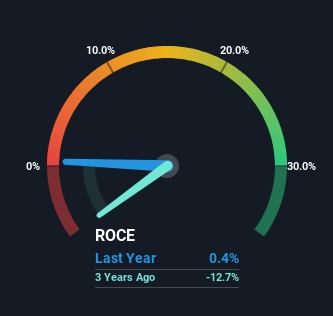- China
- /
- Transportation
- /
- SHSE:600561
Here's What's Concerning About Jiangxi Changyun's (SHSE:600561) Returns On Capital

What underlying fundamental trends can indicate that a company might be in decline? When we see a declining return on capital employed (ROCE) in conjunction with a declining base of capital employed, that's often how a mature business shows signs of aging. Trends like this ultimately mean the business is reducing its investments and also earning less on what it has invested. On that note, looking into Jiangxi Changyun (SHSE:600561), we weren't too upbeat about how things were going.
Understanding Return On Capital Employed (ROCE)
For those that aren't sure what ROCE is, it measures the amount of pre-tax profits a company can generate from the capital employed in its business. Analysts use this formula to calculate it for Jiangxi Changyun:
Return on Capital Employed = Earnings Before Interest and Tax (EBIT) ÷ (Total Assets - Current Liabilities)
0.004 = CN¥5.6m ÷ (CN¥4.4b - CN¥3.1b) (Based on the trailing twelve months to September 2023).
Therefore, Jiangxi Changyun has an ROCE of 0.4%. In absolute terms, that's a low return and it also under-performs the Transportation industry average of 3.6%.
See our latest analysis for Jiangxi Changyun

Historical performance is a great place to start when researching a stock so above you can see the gauge for Jiangxi Changyun's ROCE against it's prior returns. If you'd like to look at how Jiangxi Changyun has performed in the past in other metrics, you can view this free graph of Jiangxi Changyun's past earnings, revenue and cash flow.
How Are Returns Trending?
The trend of returns that Jiangxi Changyun is generating are raising some concerns. Unfortunately, returns have declined substantially over the last five years to the 0.4% we see today. What's equally concerning is that the amount of capital deployed in the business has shrunk by 51% over that same period. When you see both ROCE and capital employed diminishing, it can often be a sign of a mature and shrinking business that might be in structural decline. If these underlying trends continue, we wouldn't be too optimistic going forward.
On a side note, Jiangxi Changyun's current liabilities have increased over the last five years to 69% of total assets, effectively distorting the ROCE to some degree. Without this increase, it's likely that ROCE would be even lower than 0.4%. And with current liabilities at these levels, suppliers or short-term creditors are effectively funding a large part of the business, which can introduce some risks.
What We Can Learn From Jiangxi Changyun's ROCE
To see Jiangxi Changyun reducing the capital employed in the business in tandem with diminishing returns, is concerning. It should come as no surprise then that the stock has fallen 42% over the last five years, so it looks like investors are recognizing these changes. With underlying trends that aren't great in these areas, we'd consider looking elsewhere.
Jiangxi Changyun does have some risks though, and we've spotted 1 warning sign for Jiangxi Changyun that you might be interested in.
While Jiangxi Changyun may not currently earn the highest returns, we've compiled a list of companies that currently earn more than 25% return on equity. Check out this free list here.
If you're looking to trade Jiangxi Changyun, open an account with the lowest-cost platform trusted by professionals, Interactive Brokers.
With clients in over 200 countries and territories, and access to 160 markets, IBKR lets you trade stocks, options, futures, forex, bonds and funds from a single integrated account.
Enjoy no hidden fees, no account minimums, and FX conversion rates as low as 0.03%, far better than what most brokers offer.
Sponsored ContentNew: Manage All Your Stock Portfolios in One Place
We've created the ultimate portfolio companion for stock investors, and it's free.
• Connect an unlimited number of Portfolios and see your total in one currency
• Be alerted to new Warning Signs or Risks via email or mobile
• Track the Fair Value of your stocks
Have feedback on this article? Concerned about the content? Get in touch with us directly. Alternatively, email editorial-team (at) simplywallst.com.
This article by Simply Wall St is general in nature. We provide commentary based on historical data and analyst forecasts only using an unbiased methodology and our articles are not intended to be financial advice. It does not constitute a recommendation to buy or sell any stock, and does not take account of your objectives, or your financial situation. We aim to bring you long-term focused analysis driven by fundamental data. Note that our analysis may not factor in the latest price-sensitive company announcements or qualitative material. Simply Wall St has no position in any stocks mentioned.
About SHSE:600561
Jiangxi Changyun
Provides passenger road transportation services in Jiangxi Province.
Questionable track record with imperfect balance sheet.
Market Insights
Community Narratives




